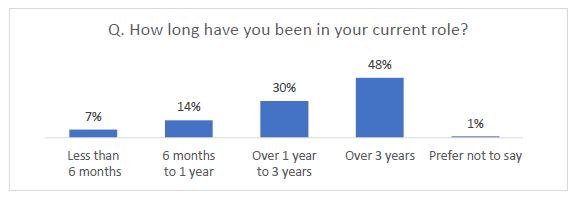The role of the village manager is both challenging and rewarding.
How challenging is reflected in the fact that for many it is a high turnover career.
In January this year we commissioned Australian Online Research (AOR) to survey the managers in villages covered in our National Resident Survey villages. 283 responded, a significant number (out of 545 invited).
From the chart above you can see 21% had been in the job for less than a year and 51% had been in the job for less than three years.
As you would know, it takes a couple of years to understand a village, its budgets, its residents, the service providers.
So this turnover is not good.
Village managers were also asked for any added comments they would like to offer. The following are some of the themes which emerged:
1. High job satisfaction
2. Dealing with unrealistic expectations of operators, residents and families:
- Increased demands of compliance, regulatory and corporate reporting, taking away from needs of day-to-day job
- Challenges of increasing care and support needs of residents as they age, which may exceed the intended ‘offer’ of a retirement village
- Unrealistic expectations for village manager to be on call 24/7
- Poor understanding of contract terms by longer-term residents
- Increased pressures to do more with same budget
3. Issues with job appeal and description undervaluing the role
- Complexities of the job undervalued, requiring complex set of skills
- Poor pay structure
- Poor job growth opportunities (e.g. promotion)
4. Insufficient staffing/support to run the village
5. Need for more authority – particularly with maintenance and approval of capital expenditures
6. Impact of bad press on the industry, perceptions and demands
7. Decline in respect by residents – no longer mutual respect, but matter of ‘we pay your wage’
Do these themes match your own?


